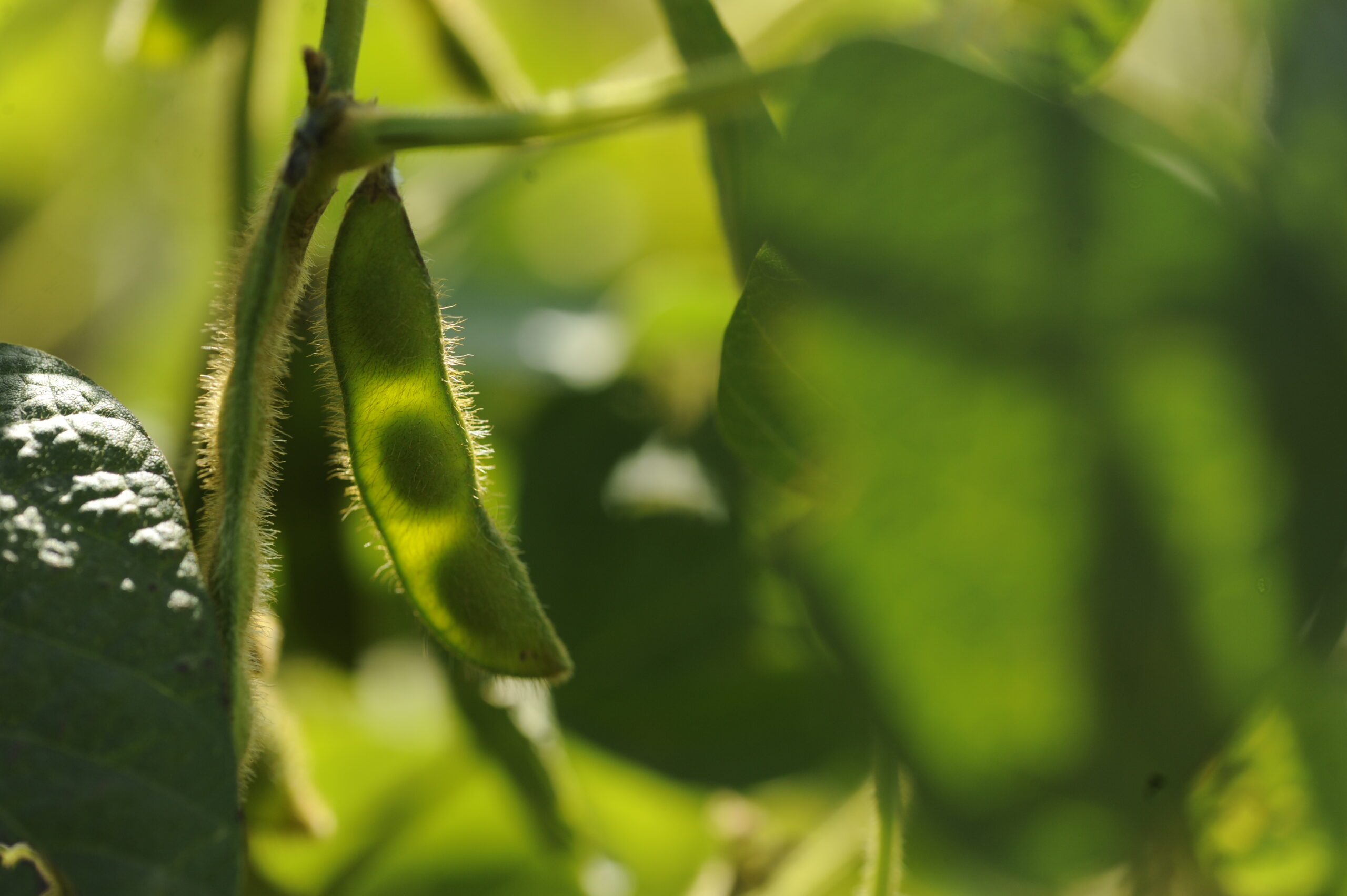Weed Management
Soybean seedlings are non-competitive and yield potential is maximized when weeds are controlled in a critical weed-free period that lasts until at least the third trifoliate. After the soybeans form a canopy, they are better able to compete with weeds. An integrated weed management system is recommended as an overall weed control system. Soybeans are typically seeded a bit later in the spring to allow the soil to warm up. This presents a good opportunity to control weeds prior to seeding or prior to crop emergence in the spring. Herbicide selection will vary based on the production system, as various herbicide-tolerant traits are available in different varieties. When choosing in-crop herbicides care should be taken to check labels before application and avoid drift concerns. Generally, weed management is accomplished by registered herbicide application, both pre-seed and in-crop. Growers should also be aware of past herbicide applications on fields planted to soybeans, as residual herbicides such as chlopyralid, metasulfuron, and dicamba (if not a dicamba-tolerant variety) may cause injury to soybeans.
Since some herbicide systems developed in soybeans are the same as those developed in canola (for example Round Up Ready® and Liberty Link®), volunteer herbicide-tolerant canola is often a primary weed of concern in soybean production. However, a wide range of commercial herbicides are registered for use in soybeans, and there are many different herbicide options to tank mix to address these concerns.
Related Resources
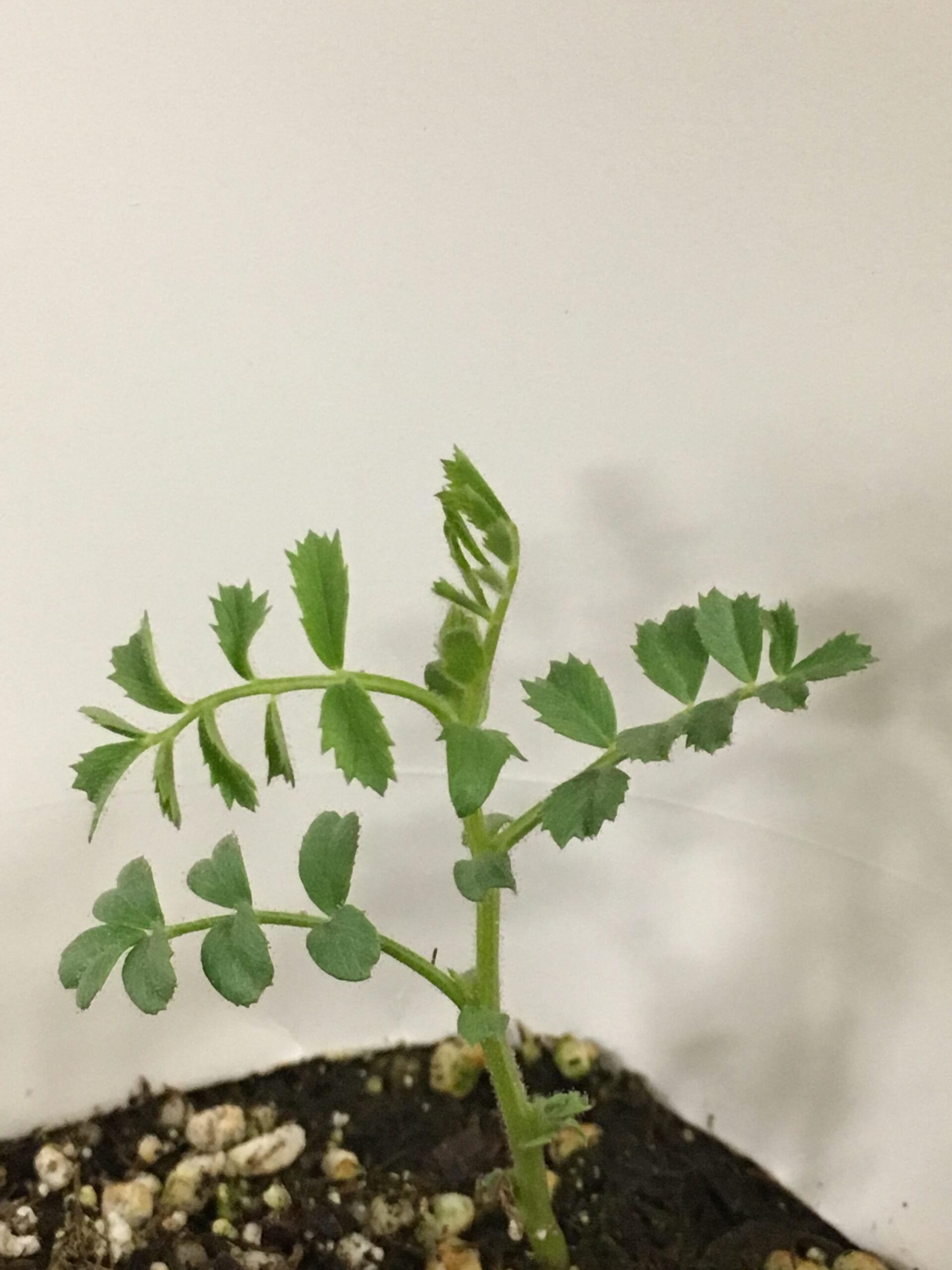
Staging Pulses for Herbicide Applications In-Crop
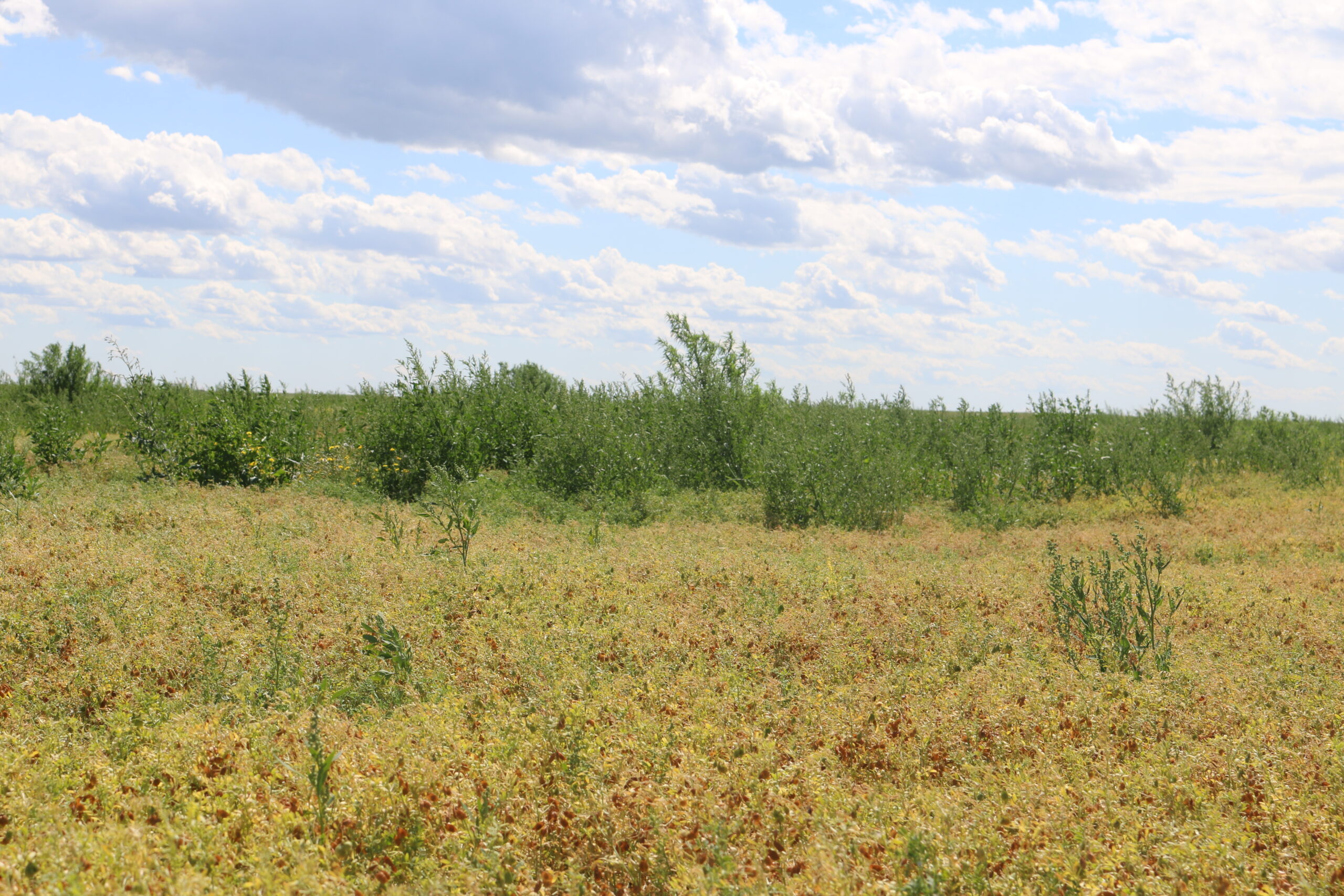
Critical Period of Weed Control in Pulses
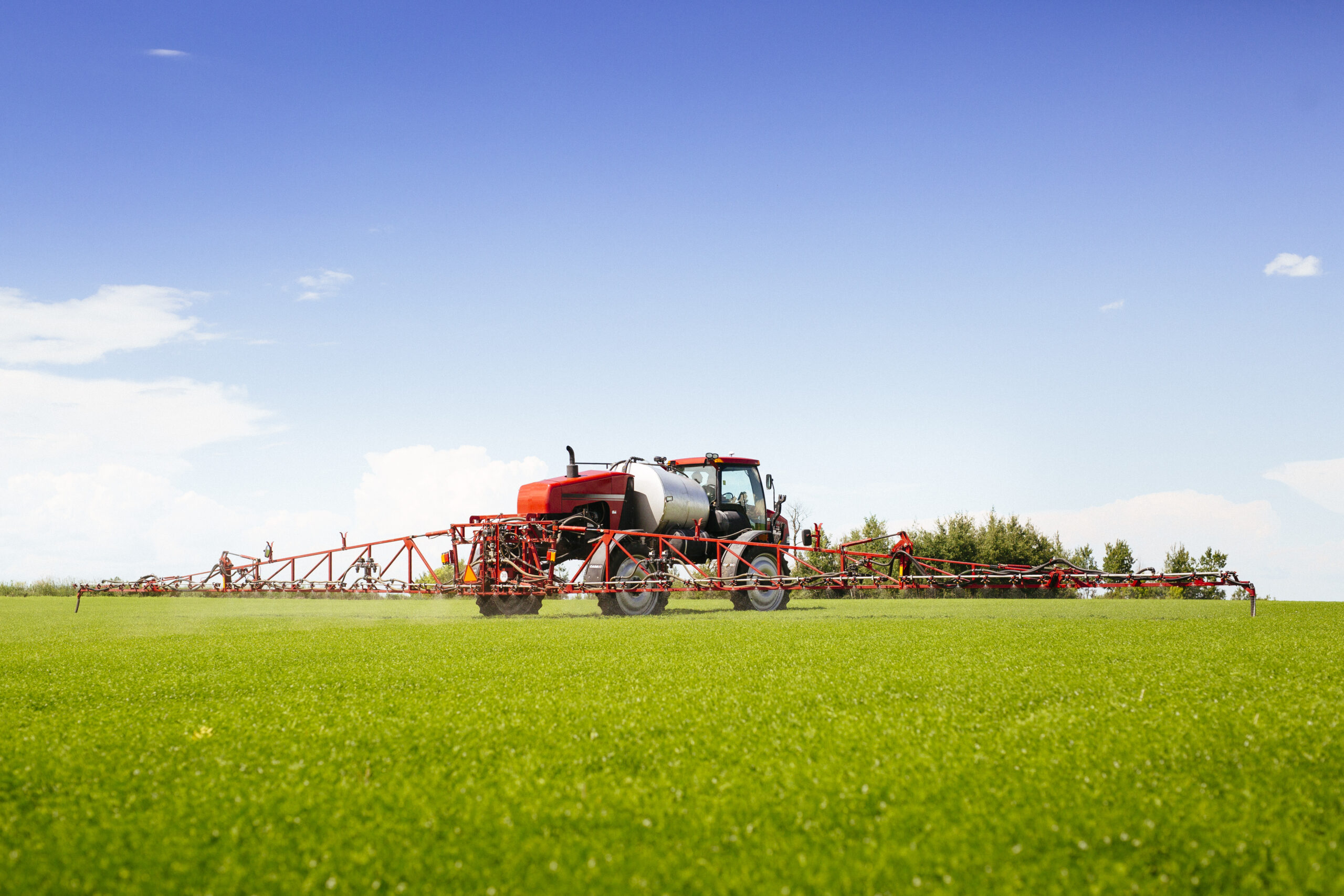
Post-Emergent Herbicide Options for Soybeans
Disease Management
Soybeans are susceptible to many different diseases. Fungus, bacteria, and viruses can all negatively affect soybean growth. In addition to disease, nematodes feeding on roots can cause above-ground symptoms like root rot diseases. Other non-infectious disorders can also mimic disease symptoms, so careful scouting and management of the crop is important to correctly identify the pathogen affecting the crop. In Saskatchewan many of the diseases have yet to establish at high incidence since soybeans are still a relatively new crop. As soybeans become more established in Saskatchewan, the incidence of some of these diseases may increase as well.
Many management practices can reduce the risk of some diseases. Cultural control methods can play a large role in reducing disease pressure for the growing season. Growers should consider:
- Seed Source and Handling: Planting clean seed that is disease free. Many diseases can be carried on the seed such as downy mildew, cercospora leaf blight, bacterial blight, and white mould. Seed should be handled gently both in storage and seeding operations to avoid damage to the seed coat.
- Variety Selection: Many sources of resistance are available for several different diseases. If a particular disease is of concern, checking the ratings when selecting a variety is good practice.
- Weed Control: Keeping the crop weed free will help reduce canopy cover and provide a drier canopy, as some weeds can host pathogens further increasing disease pressure.
- Proper Fertilization: Balancing nutrition is important to avoid nutrient deficiencies that may stress the plant and make it more susceptible to disease.
- Crop Rotation and Tillage: Proper crop rotation and burial of infested crop residue using conservation tillage practices can reduce pathogen levels of some diseases. Avoiding compaction and breaking up hardpans can also help reduce stress on roots, helping to decrease disease incidence and severity.
Seed treatments will help protect seed and seedlings from seed-borne and soil-borne pathogens, to help ensure good establishment of a strong, vigorous crop. Foliar fungicide applications can be used to target identified diseases during the growing season at the correct timing, to maximize effectiveness and protection of yield.
Root Rots
Several different pathogens can cause root rots in soybeans, and the most common tend to be Fusarium, Rhizoctonia, Phytophthora, and Pythium. They can kill and rot seeds before germination or cause seedling death. They are most common when soil is very wet in the first few weeks after planting, and in heavy, poorly drained soils. Planting crops into warm soils that encourage rapid growth and emergence, as well as using seed treatments, can help avoid economic infections. The different pathogens have different optimal conditions. For example, Phytophthora and Rhizoctonia are favored by wet and warm soils, whereas Pythium is typically favored by wet and cool soils. Seed and seedling diseases may be enhanced by slow germination and growth of soybeans, poor quality seed, and plant stress.
Evidence of seed and seedling diseases is usually seen when seedlings do not emerge, or they die or are stunted. Infection and damage prior to emergence are common but difficult to identify. Factors other than disease can also cause these problems, so it is important to look closely to determine the cause(s). Different seedling diseases may cause different symptoms, but similarities can make them difficult to distinguish.
Favoured by saturated warm soil, Phytophthora is a major disease of soybeans and can attack throughout the growing season, all the way up to maturity. Early season symptoms include seed rot and pre- and post-emergence damping off. Stems of infected seedlings appear water-soaked, while leaves may become chlorotic, and plants will wilt and die. Older plant symptoms will vary depending on variety. Susceptible varieties become chlorotic between veins, and plants wilt and die with withered leaves attached. Varieties that are not fully susceptible may appear stunted, but plants are typically not killed. The most characteristic symptom of Phytophthora is a dark brown lesion on the lower stem that extends up from the taproot of the plant, often a high as several nodes. This lesion has the potential to eventually girdle the stem and stunt or kill the plant.
Phytophthora sojae survives in soil from five up to 10 years in association with decomposed soybean tissues. Soybeans are the only known crop host for this pathogen. Crop rotation, variety selection, and seed treatments can be used to minimize effects.
Pythium is a soil-borne, fungal-like pathogen. Several different species damage soybeans. The various species of Pythium that infect soybean have a wide host range that can include many other crops. Pythium tends to be favoured by cool and moist soil, but some species may do more damage in warm soils.
Pythium can attack rotting seeds and seedlings prior to emergence and can cause post-emergence damping-off under wet conditions. The characteristic symptom of most Pythium infections is soft, brownish-coloured, rotting tissue. Infected seeds appear rotted and soil sticks to them. Seedlings have water-soaked lesions on hypocotyl or cotyledons that develop into brown soft rot. Pythium causes symptoms like Phytophthora in seedlings and can only be distinguished by laboratory examination. Although Pythium causes most damage to seeds and seedlings, roots of established plants can be rotted, and plants may be stunted. Older plants become yellow, stunted, or wilted if infection is severe. Saturated soils are critical for infection of all Pythium species. Well drained fields help reduce disease, as well as avoiding planting in cold, wet soils. Seed treatments are also effective against Pythium spp.
Rhizoctonia infects young seedlings causing pre- and post-emergence damping off. In seedlings and older plants, a firm, rusty-brown decay, or sunken lesion on the root or on the lower stem is a characteristic symptom. The infections can be superficial and cause no noticeable damage, or they can girdle the stem and stunt or kill plants.
Fusarium is a common pathogen that can damage seeds and seedlings. It causes light to dark brown lesions on roots that may spread over much of the root system and may appear shrunken. Fusarium may attack the tap root and promote adventitious root growth near the soil surface and may degrade lateral roots.
Aphanomyces is a root disease that has been extremely problematic in many pulse crops, but soybeans are currently considered a non-host of Aphanomyces. In general, these diseases can be reduced by planting good-quality seed in well-drained, non-compacted fields. Delaying planting until soils are warmer than 10°C and relatively dry, to allow for rapid emergence and growth, can be beneficial. Crop rotation and tillage may be of some benefit. Genetic resistance in soybean varieties is available for managing Phytophthora infections.
The soybean cyst nematode has not yet been found in Western Canada but is a major economic disease of soybeans worldwide. Fields in areas frequently in soybean rotation should be carefully monitored. The soybean cyst nematode may not develop obvious symptoms even though yield loss occurs. Noticeable symptoms include stunted, slow growing crops that have little-to-no canopy closure and chlorotic foliage. Infected plants have poorly developed root systems and fewer nodules formed. Roots need to be dug up and soil carefully checked for white female nematodes starting about six weeks after crop emergence. To get an idea of the amount of soybean cyst nematode in the soil, a soil sample should be sent to a diagnostic lab. Plant damage occurs from both the direct effects of the nematode feeding, as well as indirectly from wounds that allow openings for other soil pathogens. Once established in a field, it is impossible to eliminate. Resistant varieties exist to manage soybean cyst nematode but are not resistant to all populations. Most contain only one source of genetic resistance, so rotating sources of resistance can help prevent the development of more damaging soybean cyst nematode populations. Cleaning equipment to avoid moving it from field to field is a good practice, as well as longer rotations between host crops to help decrease numbers.
Foliar Diseases
Sclerotinia sclerotiorum or Scelrotinia stem rot affects many different broadleaf crops grown in Saskatchewan and affects soybeans as well. However, soybeans are more tolerant than canola, dry beans, and sunflowers. If 10% or more plants are affected, yield loss can be expected.
White mould is easily recognized by fluffy, white growth on stems. Initial symptoms develop from reproductive (R) 3 to R6 as gray to white lesions at the nodes. Lesions rapidly progress above and below the nodes, sometimes girdling the entire stem. Characteristic black sclerotia will become visible, embedded in the white mycelium on the stem lesions and inside the stem.
Some varieties are moderately resistant to Sclerotinia, so variety selection can influence disease severity. Open canopies that have increased air flow are also less susceptible to Sclerotinia developing. Crop rotation is difficult, as many other crops are hosts as well, and spores can move long distances in the air to affect nearby crops. Controlling weeds is also important as many broadleaf weeds are hosts as well. Foliar fungicides are available to help manage white mould in soybeans.
Septoria glycines or brown spot is a common foliar disease of soybeans that develops soon after planting and is usually present throughout the growing season. Yield losses depend on how far up the canopy the disease progresses during grain fill.
It is typically a milder disease during vegetative growth stages, with infected plants exhibiting purple lesions on unifoliate leaves. Lesions on later leaves are small, irregularly shaped, and dark brown. Infected leaves will turn yellow and drop. Lesions on stems, petioles, and pods are not as common but are similar in appearance. While foliar fungicides can be applied during R3 to R5 growth stages to slow rate of disease development and protect yield, it is usually not of economic importance in Saskatchewan.
Bacterial blight is another very common foliar disease, however, it seldom causes serious yield loss. Together with Septoria brown spot, it is usually the first foliar disease to occur on soybean in most growing seasons. Infections can first occur on the cotyledons, and as plants grow, young leaves are most susceptible. Lesions are small, angular, and reddish-brown with water-soaked margins, surrounded by a yellow halo. As the disease progresses, lesions often grow together to produce large, irregularly shaped dead areas. Centres of older lesions often fall out, leaving leaves appearing tattered. On stems and petioles lesions are large and black. Bacteria survive the winter in crop residue and seed. They are spread with rain and wind, and infection occurs through wounds on the plant, making outbreaks common after rainstorms with high winds. Cool, rainy weather favours disease, and high temperatures will slow or stop development.
Since it is a bacterial blight, foliar fungicides are not effective against it. Some varieties appear more susceptible than others, but good crop rotation and tillage to reduce survival of the bacteria, will help decrease pathogen levels.
Downy mildew is a common disease of soybeans but seldom causes serious yield loss. The pathogen may also infect seed and reduce seed quality. The disease may affect seedlings but is more common in later vegetative and reproductive growth stages. Lesions occur on upper surfaces of leaves as irregularly shaped, pale green to light yellow spots. Older lesions turn brown with yellow-green margins. On the underside of the leaf, fuzzy, gray tufts may be seen growing from the lesions, especially when humidity is high. Infected pods show no symptoms externally, but inside the pod and seed may be covered with a dried, whitish fungal mass that appears crusty. Infected seeds can be smaller and appear dull white with cracks in the seed coat.
Many sources of resistance are available in varieties to help manage the disease, and foliar fungicides are available, but it is usually not an economic concern.
Powdery mildew is more prevalent in cooler seasons. It is characterized by white, powdery fungal growth that can cover all above-ground plant parts, particularly the upper surface of leaves. It usually does not appear until mid- to- late reproductive phases. Most commercial varieties are resistant, and unless it initiates early (July), there are not usually economic reasons to control it. There are foliar fungicides available if infection is early and severe.
Frogeye leaf spot (Cecospora sojina) is slowly becoming more prevalent in northern geographies, and in fields under continuous soybean rotations. It can be carried on the seed, and early infections resulting from infected seed will result in stunted seedlings. Later in the season, infections on leaves, stems (less common), and pods start as dark, water-soaked spots that vary in size. As they age, the central area becomes gray to light brown, with dark, red-brown margins. It can result in premature leaf drop and infect seeds if pods get lesions. Infected seeds have light to dark gray discolored blotches, and often seed coat breakage.
There are resistant varieties available, and crop rotation to help reduce spore loads is recommended. Foliar fungicides applied during late flowering and early pod set can improve seed quality and yield when disease is present.
Colletotrichum truncatum or Anthracnose stem blight is generally a later-season disease that is prevalent on maturing soybean stems, but soybeans are susceptible to infection throughout the growing season. Warm, wet weather favours infection, as the fungus is sensitive to drying, and must be wet continuously for 12 hours or more for successful infection. The disease can be carried on infected seed that may or may not show any symptoms. Early infections result in damping off if infected seed is planted. Leaves, pods, and stems may also be infected without showing symptoms. When symptoms are present, they include reddish veins, leaf rolling, and premature defoliation. Stems and petioles appear to have irregularly shaped red to dark brown blotches during early reproductive stages, and later black fungal bodies are present in the lesions. There is no known varietal resistance, but crop rotation can help reduce incidence, as well foliar fungicides are available for control.
Pod and stem blight (Phomopsis longicolla) is a disease that causes seed decay, stem canker, and pod and stem blight. The fungi survive winter in infected seed and crop residue. Infection can occur early in the growing season without causing symptoms. All parts of the plant, stem, petioles, pods, and seeds are all susceptible to infection. Disease is favoured by warm, humid weather when maturing, and if harvest is delayed due to wet weather.
The most characteristic sign of pod and stem blight is linear rows of black specks (pycnidia) on mature stems of soybeans. Poor seed quality may result from infection in pods. Seed infected is cracked, shriveled, and covered with chalky, white mould. Infected seed, if planted, will rot, or have blight. Ensuring seed supply is free of disease is important in managing pod and stem blight. Foliar fungicides are also registered for control in-season, which may help protect quality, but may not impact yield much.
Many other diseases may also infect soybeans in Saskatchewan as they become an established crop, but currently they are seldom observed. These include stem canker, various stem rots, soybean rust, sudden death syndrome, and bacterial pustule.
Several different viruses can be transmitted to soybeans from feeding insects. Viruses cannot be targeted with foliar fungicides, so proper identification of the pathogen is important to determine appropriate management. Some viruses affecting soybeans include alfalfa mosaic virus and soybean mosaic virus, which are both spread by aphids. The bean pod mottle virus is spread by a beetle. Visual symptoms closely mimic damage from herbicide drift, and diagnosis based on visual symptoms alone is difficult. Foliar insecticides may help control beetle populations for bean pod mottle, but generally are not effective in reducing transmission of alfalfa mosaic virus and soybean mosaic virus by aphids.
Related Resources
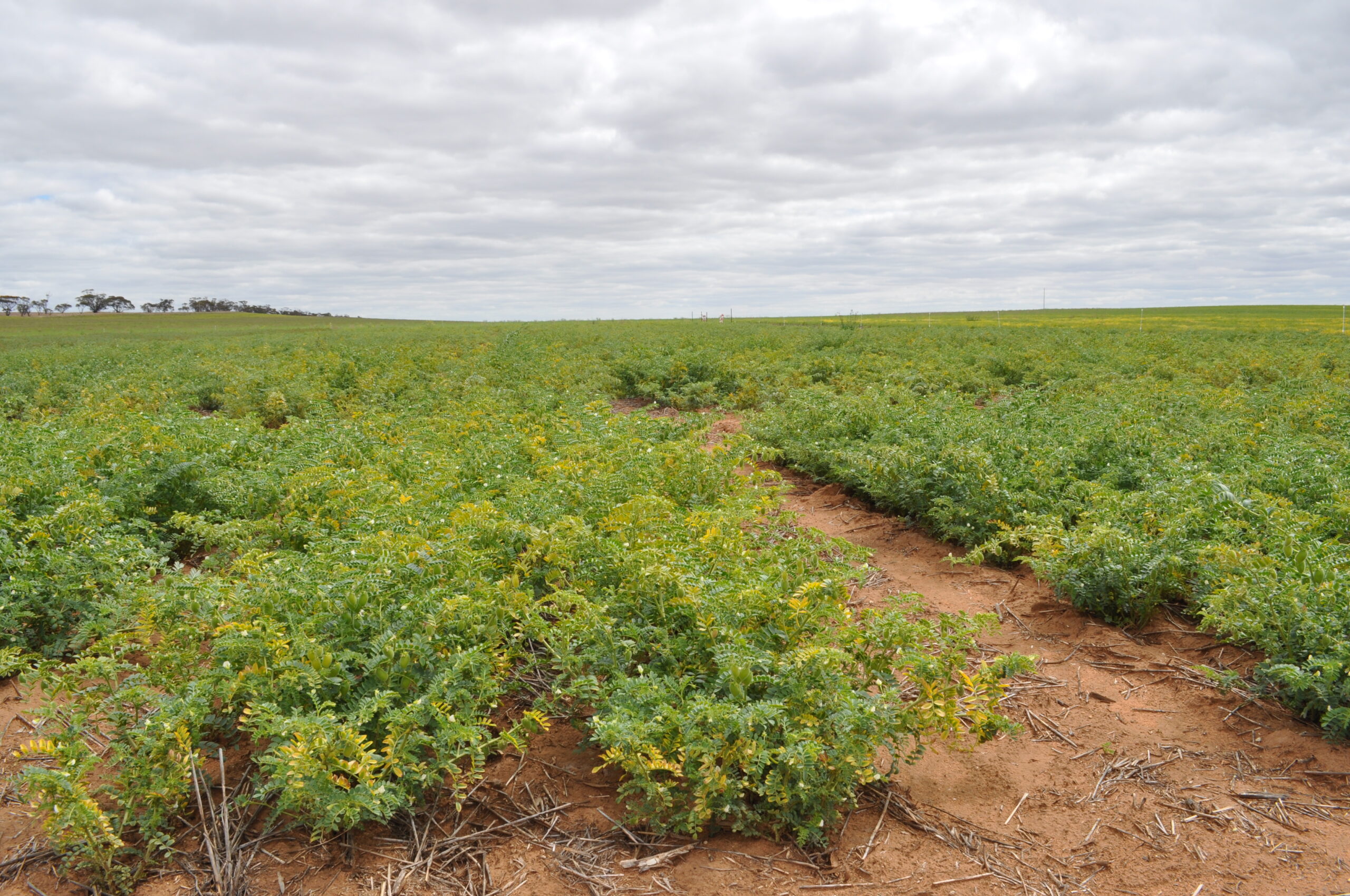
Viruses in Saskatchewan Pulse Crops
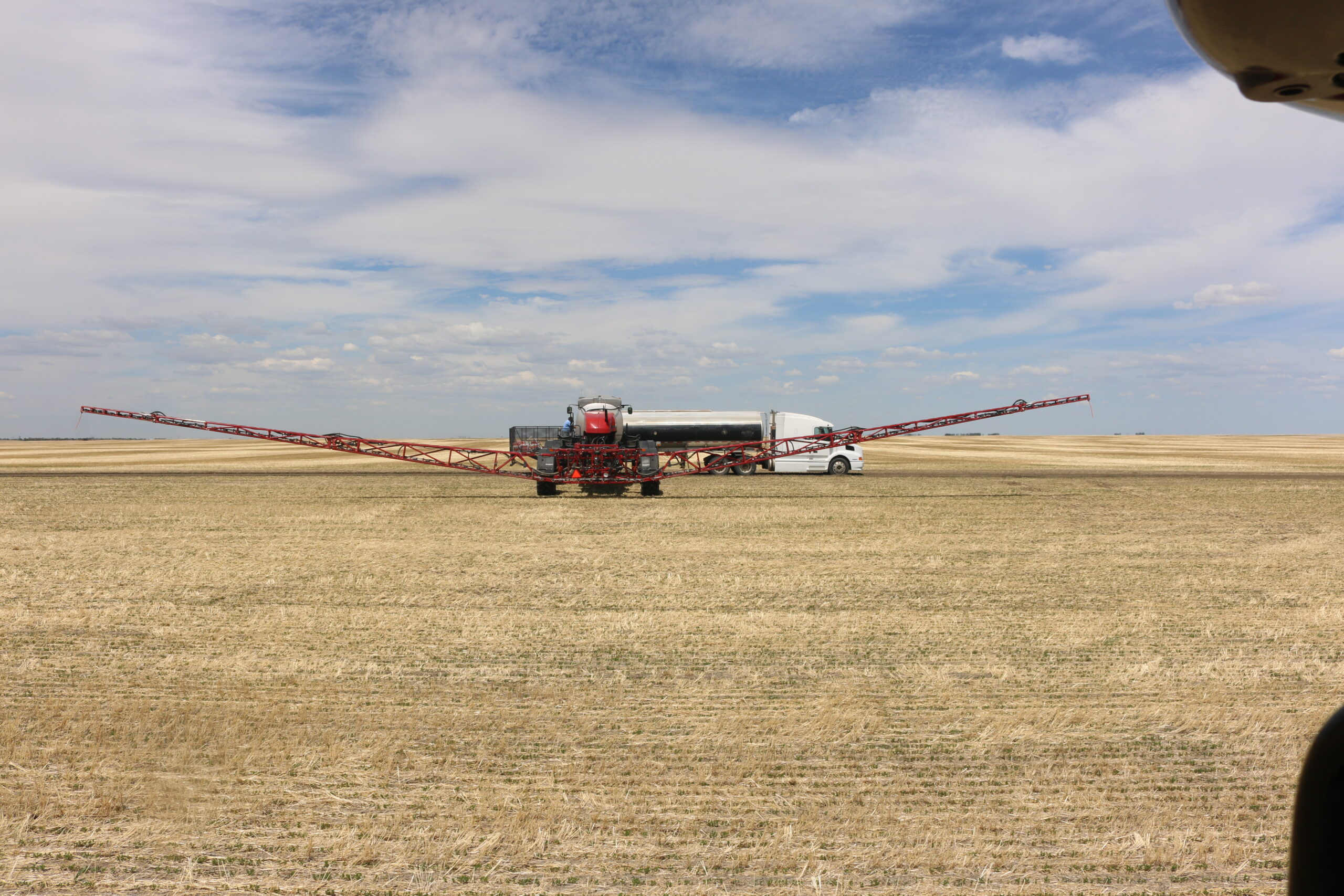
Soybean Fungicide Options
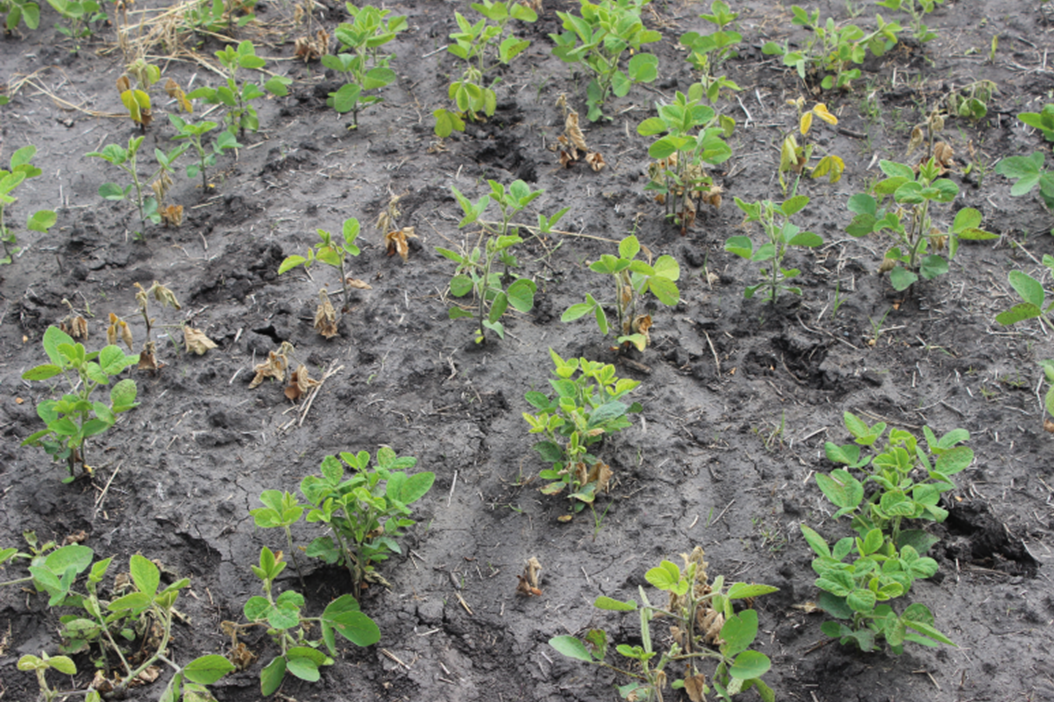
Phytophthora Root Rot in Soybeans
Insect Management
Insects of concern in soybeans include below-ground feeders, sap feeders, as well as defoliators. Crops should be scouted throughout the growing season to monitor for damage, and control measures only taken if economic thresholds are reached, to help protect beneficial insects present in the field.
Below-Ground Feeders
Wireworms are small-segmented, tan-coloured worms that live in the soil and will feed on a variety of plant hosts. Adult wireworms are beetles that do not do economic damage to crops. Larvae will migrate near the germinating soil in early spring and move back down deeper in the soil as soil temperatures climb, later in the summer. Damage can be seen in the field by wilting plants, resulting from wireworms chewing on the stems, and may appear like cutworm damage. The distinction is that wireworm feeding often looks more like the stem is shredded, and it is usually still attached to the roots, whereas cutworm feeding cuts the stem right off. There are seed treatments available to control wireworms, as they cannot be controlled by foliar sprays, as they stay below-ground.
The adult seedcorn maggot looks like a common house fly and will emerge from eggs in the soil in late May. The adult then lays eggs in moist cracks in the soil that hatch after two to four days when temperatures are 10°C. Larvae is white, tough skinned, and roughly a quarter inch long. They will burrow into both the seed and the stem of developing soybean plants, resulting in thinned stands and wilted plants. Damage is worse when germination and emergence is delayed, so ensuring planting as early as possible into a warm, shallow seedbed to encourage fast emergence may help limit damage. Sprays are not effective and seed treatments are the only control registered to protect against the seedcorn maggot.
Cutworms are the larvae of several different types of moths and overwinter in the soil as pupae. Larvae emerge from the pupae in the spring and feed on new plants. There are many different species of cutworms in Saskatchewan, affecting and eating many different types of crops. Soybeans are no exception and can be cutoff below the soil surface by cutworms. Soybeans do not have growing points below-ground and therefore cannot regrow after being cut off by cutworms. Crops should be scouted regularly in early spring, and if dead wilted plants are observed, the soil around and up the row from the plant should be examined for the presence of cutworms. The feeding behavior will vary depending on species, but most feed at night and will be below the soil surface, up to a depth of 2 inches (in) during the day.
Sap Feeders & Sucking Insects
A variety of different aphids can be present in many crops. Occasionally, soybean aphids will become a significant pest of soybeans in Saskatchewan. Adult aphids are very small, around 1.5 millimetres (mm) long, yellowed bodied, with distinct black cornicles, and can be wingless or winged. They are most often found on the underside of the newest leaves. If found on the stem or petioles, it is usually an indication that the number of aphids on the plant is very high, as this tissue is a less desirable food source and normally aphids only migrate there if crowded. Aphids rarely overwinter in Saskatchewan, and most are blown in on warm, southerly winds from the United States (U.S.) in June, or early July.
Depending on weather conditions there may be from seven to 15 generations per season, and if conditions favour multiple generations, then populations may increase to levels where control is warranted. Populations can increase very rapidly because of their ability to clone themselves, so when identified, populations should be monitored closely. Natural pests such as the lady bird beetle, minute pirate bug, damsel bug, syrphid fly larvae, and several parasitic wasps can help control populations. In warm, moist weather a fungal disease can also affect aphids.
Soybean aphids suck out plant juices from the plant. This can cause a reduction in vigour, growth rates, leaf puckering, and reduced pod and seed counts. All these factors may ultimately result in yield loss. The damage is increased if the plant has other stressors, such as drought. Additionally, aphid honey dew, produced as a waste product during feeding, promotes the development of gray, sooty mould on leaf surfaces, reducing photosynthetic capacity of plants.
Economic thresholds depend on the growth stage of the crop, and the presence of other stressors. Generally, 250 aphids per plant is when control may begin to become warranted. Soybeans can tolerate quite a bit of feeding, and some research shows that 670 aphids per plant are required to cause enough damage to cover insecticide costs. However, the trigger is set at 250 because populations can increase very quickly, and it allows for some application time to control them prior to economic damage being sustained.
Two spotted spider mites are more closely related to spiders than to insects, and will overwinter in soil, debris, and grass. They commonly overwinter in alfalfa fields and are carried by winds into soybean fields in mid-to-late summer. They are extremely small and difficult to see on the plants, and damage is usually noticed before the mite. Shaking leaves showing symptoms over a white piece of paper and looking for small dark specs coming off helps to identify mites. Also look carefully at the undersides of leaves for eggs, they may be noted by minute webbing covering them. Two spotted spider mites are yellow orange in colour, with two distinct black spots on each side of the body. The use of a 10 times magnifying lens aids in identification and verification of a mite infestation.
Spider mites suck the contents of the cell out using piercing, sucking mouth parts, and render the cell non-functional. Cells then turn yellowish and eventually brown, leaving a mottled, sandblast effect on the leaf when observed up close, which may look just like a general yellowing from farther away. Since mites often overwinter in grasses and clovers, you may notice an edge type effect from the mites moving in from edges of the field. Once in a crop, there may be seven to 10 generations per season, and in severe infestations, yield losses from 40–60%.
There is limited information for economic thresholds, but recommendations based on visual damage suggest an insecticide application if 25% of the leaves show discolouration prior to seed set, or 10% of the leaves if pods have set. Since spider mites often move in from field edges, growers could consider the potential for spot treatment if populations appear to be severe. Natural predators such as the predatory spider mite, minute pirate bug, and mite destroyer beetle can help keep populations in check. As well, Neozygites floridana is a fungal agent that can infect and kill spider mites.
Defoliators and Above-Ground Feeders
To determine if control is required with many of the defoliating insects in soybeans, a reference to the % defoliation of the plant is made. Soybeans are quite good at tolerating defoliation in the vegetative stage, with little reduction in yield until 30–40% defoliation occurs. In the reproductive phase they can tolerate less, but still up to 20% defoliation may not impact yield. Once pods are full, thresholds increase again to around 35% defoliation.
Grasshoppers feed on the foliage of almost any crop, however soybeans are not a preferred food source. Growers may notice grasshoppers moving into fields are feeding on weeds, rather than soybeans.
There are no economic thresholds established for grasshopper in soybeans, but there is information on effects of defoliation on soybean yield. Generally, soybeans can tolerate quite a bit of defoliation, and over 25% leaf defoliation would need to be reached to consider control of grasshoppers. There may be some feeding on soybeans, and field edges may see higher infestations as grasshoppers move in from field borders. Up to 40% defoliation in vegetative stages of soybeans could result in a yield reduction of 3–7%, similarly at pod set and seed fill stages, 20% defoliation could cause similar losses. Growers should watch to ensure grasshoppers are not feeding on pods, as action may need to be taken sooner if pods are being affected.
Thistle caterpillars are sporadic pests in soybeans. They do not overwinter in Saskatchewan and migrate northward from the southern U.S. Their host crops include soybeans, Canada thistle, and sunflowers. Caterpillars grow to be 2 to 3 centimetres (cm) long and are brown and black with yellow stripes down each side. They are covered in branched spiny hairs, giving them a bristly appearance. They are often found where they feed on leaves, inside a webbed area formed by cupping leaf margins together. Caterpillars form a goldish/brown chrysalis that hangs from the plants, and the painted lady butterfly will emerge. Several generations of thistle caterpillars can occur in one season. Like grasshoppers, there are no established economic thresholds based on the number of caterpillars, rather a focus on the amount of defoliation that is occurring. At vegetative stages prior to flowering, defoliation should be greater than 30% to warrant control. When flowering and in reproductive stages, 20% defoliation is considered a threshold.
Thistle caterpillars are sporadic pests in soybeans. They do not overwinter in Saskatchewan and migrate northward from the southern U.S. Their host crops include soybeans, Canada thistle, and sunflowers. Caterpillars grow to be 2 to 3 centimetres (cm) long and are brown and black with yellow stripes down each side. They are covered in branched spiny hairs, giving them a bristly appearance. They are often found where they feed on leaves, inside a webbed area formed by cupping leaf margins together. Caterpillars form a goldish/brown chrysalis that hangs from the plants, and the painted lady butterfly will emerge. Several generations of thistle caterpillars can occur in one season. Like grasshoppers, there are no established economic thresholds based on the number of caterpillars, rather a focus on the amount of defoliation that is occurring. At vegetative stages prior to flowering, defoliation should be greater than 30% to warrant control. When flowering and in reproductive stages, 20% defoliation is considered a threshold.
Green cloverworms are only an occasional pest of soybeans. They do not overwinter in Saskatchewan, migrating north in the spring. They may have one or two generations per year. These caterpillars are green, with two narrow, white stripes down the side. When mature, the worms are 2–4 cm long. These caterpillars have only three pairs of fleshy prolegs on the abdomen, plus a pair of prolegs on the back segment. When moving, the worms move by arching the middle of the body, or looping. Young worms scrape leaf tissue, creating a transparent skin, or window on the leaf surface. Older cloverworms eat holes in the leaves. Damage can be confused with grasshopper defoliation, or damage from other worms. Shaking plants over a sheet to dislodge worms can help identify what is present. While they may be confused with an alfalfa looper because they loop when they walk, they are different in that they will wiggle vigorously if disturbed.
When cloverworms are actively feeding, % defoliation can be used to determine if control is required. At pre-bloom stage, 40% defoliation, at bloom-pod fill, 20% defoliation, and at pod fill harvest, 35% defoliation is tolerated. An average infestation of four to eight larvae per row foot typically causes 20–30% defoliation.
